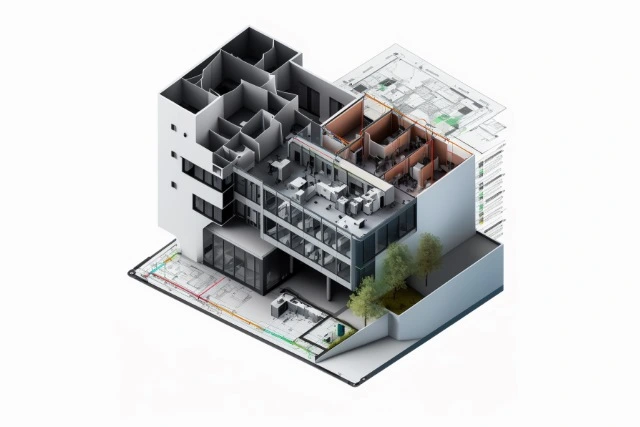Definition
A Building Management System (BMS) is a computer-based system that controls and monitors a building’s mechanical and electrical equipment such as ventilation, lighting, power systems, fire systems, and security systems. It provides real-time monitoring, data analytics, and automation to improve efficiency, safety, and sustainability in building operations.
Property owners strive to minimize operational expenses and ensure tenant safety and comfort. By connecting facility systems (IoT technology) and controlling them from one place, building management systems can make for a smart building and enable property owners to find hidden opportunities.
What is Building management systems (BMS)?
Building Management System (BMS), also known as a Building Automation System (BAS), is a centralized control system that monitors and manages the mechanical, electrical, and environmental functions within a building. It integrates HVAC, lighting, security, energy management, and other key systems to optimize performance and efficiency.
The principal aim of the BMS is to streamline operations, making them easier to manage, monitor, and improve.
Why a BMS is important
- Reduces operational costs through automation and energy optimization.
- Improves occupant comfort with dynamic environmental controls.
- Enhances security and compliance by integrating safety features and regulations.
- Facilitates data-driven decision-making by collecting and analyzing real-time building performance data.
How a Building Management System Works
Smart buildings require complex monitoring of IoT networks that control the building system. Property owners can manage, monitor, and improve operations via building management systems or BMS user interfaces. A smart building can seamlessly integrate with other buildings, becoming an essential component of a smart city.
A BMS operates through three key levels:
1. Field Level (Sensors & Devices)
- Collects real-time data from temperature sensors, humidity sensors, air quality monitors, occupancy sensors, and power meters.
- Sends signals to controllers for processing and automation.
2. Automation Level (Controllers & Software)
- Processes the collected data and makes real-time decisions based on predefined logic.
- Controls mechanical and electrical equipment, including HVAC, lighting, and security systems.
3. Management Level (User Interface & Analytics)
- Provides a dashboard for facility managers to monitor and adjust settings.
- Generates reports, tracks energy usage, and sends alerts for maintenance needs.
Features & Functions of a BMS
A well-implemented BMS provides the following functionalities:
Core Functions
- HVAC Control: Adjusts heating, cooling, and ventilation automatically based on occupancy and external climate conditions.
- Lighting Management: Optimizes lighting schedules to reduce unnecessary power consumption.
- Security & Access Control: Integrates with CCTV, biometric access, and alarm systems.
- Fire Safety Monitoring: Connects with fire detection systems to trigger emergency protocols.
- Energy Optimization: Uses AI-driven analytics to enhance efficiency and minimize energy waste.
- Predictive Maintenance: Identifies potential system failures before they occur.
Benefits of a Building Management System
| Benefit | Impact |
| Energy Savings | Reduces electricity costs by 10-30% (Pacific Northwest National Laboratory, CIBSE Journal) |
| Operational Efficiency | Automates system adjustments and fault detection |
| Improved Comfort | Maintains optimal indoor air quality and temperature |
| Security & Safety | Enhances access control and fire detection |
| Sustainability | Helps meet regulatory energy efficiency standards |
Cost of Implementing a BMS
The cost of installing a BMS varies based on building size, complexity, and features:
- Small buildings: $5,000 – $50,000
- Medium-sized buildings: $50,000 – $200,000
- Large commercial buildings: $250,000+
- Estimated cost per square foot: $2.50 – $7.50 (Frazier Service Company)
- ROI: Most buildings see a payback period of 2-5 years through energy savings (Mid-Atlantic Controls).
Dr. Erik Wallin, founder, and chief ecosystem officer at ProptechOS mentions:
Future trends in building management systems are set to change how buildings are currently managed and operated. By incorporating these emerging technologies and sustainability features, building management systems will become an essential component of a smart city, creating a smarter and more comfortable environment for occupants. Proptech and sustainability go hand in hand.
Major Building Management System Providers
Several global companies lead in BMS technology:
- Schneider Electric (EcoStruxure)
- Honeywell (Niagara Framework)
- Siemens (Desigo CC)
- Johnson Controls (Metasys)
- Emerson (Supervisory Control Systems)
The main components of a BMS
Building management systems consist of three primary components, as listed below:
- Hardware: The hardware used in a BMS includes workstations, servers, sensors, and cables, to name a few components.
- Software: The software includes programming and configuring tools, graphics, and user interfaces.
- Networking components: The networking components cover the subsystems controlled by building management systems.
An open-source-based standard for integration is necessary
Property owners often need to integrate other systems within a building to become data-driven. The BMS and its data aren’t always enough. Other IoT systems and applications are frequently implemented beyond the scope of building management systems.
Building information management (BIM) is crucial. The industry must create a digital twin of the building and effectively and flexibly develop applications based on all types of data to develop and reach tenants’ expectations.
Different open-source standards exist that will allow us to achieve the above. The most comprehensive standard is RealEstateCore.
RealEstateCore is a standardized way of naming and categorizing real estate data, making it possible to compare the information of different buildings. It also allows visualization of property data in formats like 3D models. Standardized communication from various technical real estate and external IT systems is enabled, creating opportunities for advanced data analysis, efficient application development, intelligent control, and building monitoring.
Why Start Using ProptechOS?
ProptechOS transforms your BMS into an intelligent, AI-driven platform, optimizing energy use, improving tenant experience, and streamlining facility management. It connects real-time data from BMS, IoT sensors, and external sources to enable data-driven decision-making.
How ProptechOS Enhances Your BMS
- Seamless Integration – Works with major BMS vendors (Schneider, Siemens) and normalizes data for full interoperability.
- Energy Optimization – Automate HVAC and lighting based on occupancy and weather.
- Predictive Maintenance – Detects equipment failures early, reducing downtime and extending asset lifespan.
- Improved Tenant Experience – Adjusts air quality, lighting, and temperature dynamically for comfort.
- ESG & Compliance – Automates sustainability tracking (LEED, BREEAM, EU Taxonomy) and carbon reporting.
ProptechOS makes your BMS smarter, cutting costs, increasing efficiency, and future-proofing your building operations with AI-driven insights.
Do you want to learn more about advanced BMS systems? Read our semantic modelling 101 for BMS engineers.
FAQ

Dr. Erik Wallin
Chief Ecosystem Officer, and founder of ProptechOS and RealEstateCore is recognized as a leader in Building Operating Systems (BOS) and making the buildings of the world smarter. He holds an MSc and a Ph.D. in Media and Computer Science from KTH Royal Institute of Technology.
Read his full bio and information here.

